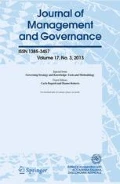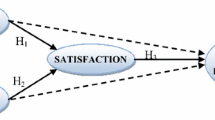Abstract
Based on stakeholders’ theory, our paper investigates the relationship between customer complaints and bank performance. We use a unique hand-collected database of customer complaints published by the banking and financial ombudsman and the financial data of the universe of Italian banks during the 2010–2017 period and employ a fixed effect panel data model and two-step system GMM estimation. We first confirm that higher complaints scaled by bank size reduce profitability and increase bank risk. Then, we show that bank institutional form affects this outcome. In contrast to cooperative banks, the performance of commercial banks is negatively influenced by customer complaints. Moreover, in contrast to medium and large banks, small banks’ profitability is not affected by customer complaints. We also found that a bank’s decision to settle customer complaints has a positive impact in the long run. The results are consistent when using normalized variables for size and different robustness checks. Consequently, managerial and policy implications related to customer complaints are proposed. Indeed, commercial banks must protect relational capital with customers by strengthening dialogue among the compliance function, complaints office and commercial areas to proactively manage the risk of complaints and improve performance. Policy makers should enhance banking transparency and simultaneously promote greater financial education of clients, which can foster trust in banks and their stability.
Similar content being viewed by others
Notes
We thank an anonymous reviewer for suggesting to deepen the relationship with respect to the bank size.
In depth, β = 0.0067 at the 10% significant level only for CEM1. For the sake of brevity, the tables are not shown in the paper and are available upon request.
References
Arbore, A., & Busacca, B. (2009). Customer satisfaction and dissatisfaction in retail banking: Exploring the asymmetric impact of attribute performances. Journal of Retailing and Consumer Services, 16, 271–280.
Arellano, M., & Bover, O. (1995). Another look at the instrumental variable estimation of error-components models. Journal of Econometrics, 68(1), 29–51.
Athanasoglou, P., Brissimis, S. N., & Delis, M. D. (2008). Bank-specific, industry specific and macroeconomic determinants of bank profitability. Journal of International Markets, Institutions and Money, 18(2), 121–136.
Baker, A. (2013). The gradual transformation? The incremental dynamics of macroprudential regulation. Regulation & Governance, 7(4), 417–434.
Bank of Italy. (2010–2017). The banking and financial ombudsman (ABF) annual report.
Bartoli, F., Ferri, G., Murro, P., & Rotondi, Z. (2013). SME financing and the choice of lending technology in Italy: Complementarity or substitutability? Journal of Banking and Finance, 37, 5476–5485.
Basel Committee on Banking Supervision. (2018). Sound practices. Implications of FinTech developments for banks and bank supervisors.
Basel Committee on Banking Supervision. (2021). Scope of application of the Basel Framework.
Baselga-Pascual, L., Trujillo-Ponce, A., & Cardone-Riportella, C. (2015). Factors influencing bank risk in Europe: Evidence from the financial crisis. The North American Journal of Economics and Finance, 34, 138–166.
Batae, O. M., Dragomir, V. D., & Feleagă, L. (2021). The relationship between environmental, social, and financial performance in the banking sector: A European study. Journal of Cleaner Production, 290, 125791.
Baum, C. F., Schaffer, M. E., & Stillman, S. (2003). Instrumental variables and GMM: Estimation and testing. Stata Journal, 3(1), 1–31.
Behery, M. H., & Eldomiaty, I. T. (2010). Stakeholders-oriented banks and bank performance: Perspectives from international business management. International Journal of Commerce and Management, 20(2), 120–150.
Berger, A. N., & Udell, F. G. (2006). A more complete conceptual framework for SME finance. Journal of Banking and Finance, 30(11), 2945–2966.
Berger, A. N., Cerqueiro, G., & Penas, M. F. (2015). Market size structure and small business lending: Are crisis times different from normal times? Review of Finance, 19, 1965–1995.
Berger, A. N., Bouwman, C. H. S., & Kim, D. (2017). Small bank comparative advantages in alleviating financial constraints and providing liquidity insurance over time. Review of Financial Studies, 30, 3416–3454.
Berger, A. N., Irresberger, F., & Roman, R. A. (2020). Bank size and household financial sentiment: Surprising evidence from university of Michigan surveys of consumers. Journal of Money, Credit and Banking, 52, 149–191.
Bikker, J. A., & Vervliet, T. B. (2017). Bank profitability and risk taking under low interest rates. International Journal of Financial Economics, 23, 3–18.
Bofondi, M., & Gobbi, G. (2009). Informational barriers to entry into credit markets. Review of Finance, 10, 39–67.
Borio, C., Gambacorta, L., & Hofmann, B. (2017). The influence of monetary policy on bank profitability. International Finance, 20(1), 48–63.
Calvet, L. E., Campbell, J. Y., & Sodini, P. (2009). Measuring the financial sophistication of households. American Economic Review, 99(2), 393–398.
Cambra-Fierro, J., Melero, I., & Sesec, F. J. (2015). Managing complaints to improve customer profitability. Journal of Retailing, 91(1), 109–124.
Coccorese, P. (2004). Bank competition and regional differences. Economics Letter, 101, 13–16.
Committee on the Global Financial System (CGFS). (2018). Structural changes in banking after the crisis. CGFS Papers, 60
Cornell, B., & Shapiro, A. C. (1987). Corporate stakeholders and corporate finance. Financial Management, 16(1), 5–14.
Demirgüç-Kunt, A., & Huizinga, H. (1999). Determinants of commercial bank interest margins and profitability: Some international evidence. World Bank Economic Review, 13(2), 379–408.
DeYoung, R., & Roland, K. R. (2001). Product mix and earnings volatility at commercial banks: Evidence from a degree of total leverage model. Journal of Financial Intermediation, 10, 54–84.
DeYoung, R., Hunter, R. W., & Udell, G. F. (2004). Past, present and probable future for community banks. Journal of Financial Services Research, 25(2), 85–133.
Dyer, J. H., & Singh, H. (1998). The relational view: Cooperative strategy and sources of interorganizational competitive advantage. Academy of Management Review, 4, 660–679.
EBA. (2017). Guidelines on internal governance under directive 2013/36/EU. EBA/GL/2017/11.
EBA. (2018). EBA report on the impact of FinTech on incumbent credit institutions’ business.
ECB. (2005). What determines Euro area bank profitability?. Financial Stability Review.
ECB. (2014). Asset quality review, phase 2 manual.
ECB. (2015). Bank profitability features in Euro area banks: The role of cyclical and structural features. Financial Stability Review, pp. 134–145.
ECB. (2020a). ECB staff macroeconomic projections for the euro area.
ECB. (2020b). Supervisory review (SREP)—aggregate SREP outcome for 2019.
Elsas, R., Hackethal, A., & Holzhäuser, M. (2010). The anatomy of bank diversification. Journal of Banking and Finance, 34(6), 1274–1287.
European Commission. (2019). The 2019 EU justice scoreboard. Retrieved from https://ec.europa.eu/info/sites/info/files/justice_scoreboard_2019_en.pdf. Accessed 9 Sept 2021.
Flannery, M. J., Kwan, S., & Nimalendran, M. (2004). Market evidence on the opaqueness of banking firms’ assets. Journal of Financial Economics, 71(3), 419–460.
Fornell, C., & Wernerfelt, B. (1987). Defensive marketing strategy by customer complaint management: A theoretical analysis. Journal of Marketing Research, 24(4), 337–346.
Freeman, R. E. (1984). Strategic management: A stakeholder approach. Pitman.
Gaganis, C., Hasan, I., & Pasiourase, F. (2020). National culture and housing credit. Journal of Empirical Finance, 56, 19–41.
Gambetta, N., Zorio-Grima, A., & García-Benau, M. A. (2015). Complaints management and bank risk profile. Journal of Business Research, 68, 1599–1601.
Garca-Herrero, A., Gavilá, S., & Santabárbara, D. (2009). What explains the low profitability of Chinese banks? Journal of Banking and Finance, 33(11), 2080–2092.
Goddard, J., Molyneux, P., & Wilson, J. O. S. (2004). The profitability of European banks: A cross-sectional and dynamic panel analysis. The Manchester School, 72(3), 363–381.
Hallowell, R. (1996). The relationships of customer satisfaction, customer loyalty, and profitability: An empirical study. International Journal of Service Industry Management, 7(4), 27–42.
Héroux, S., & Roussy, M. (2020). Three cases of compliance with governance regulation: An organizational learning perspective. Journal of Management and Governance, 24, 449–479.
IMF (2020). World economic outlook update. A crisis like no other. An uncertain recovery.
Jappelli, T., & Padula, M. (2013). Investment in financial literacy and saving decisions. Journal of Banking and Finance, 37(8), 2779–2792.
Jensen, M. C. (2001). Value maximisation, stakeholder theory and the corporate objective function. Journal of Applied Corporate Finance, 14(3), 8–21.
Kale, P., Singh, H., & Perlmutter, H. (2000). Learning and protection of proprietary assets in strategic alliances: Building relational capital. Strategic Management Journal, 21(3), 217–237.
Krishnan, M. S., Venkatram Ramaswamy, M. C., & Damien, M. P. (1999). Customer satisfaction for financial services: The role of products, services, and information technology. Management Science, 45(9), 1194–1209.
La Porta, R., Lopez-De Silanes, F., & Shleifer, A. (2002). Government ownership of banks. The Journal of Finance, 57, 265–301.
Leaven, L., & Levine, R. (2007). Is there a diversification discount factor in financial conglomerates. Journal of Financial Economics, 85, 331–367.
Lenart-Gansiniec, R. (2016). Relational capital and open innovation—in search of interdependencies. Procedia - Social and Behavioral Sciences, 220, 236–242.
Leung, W. S., Songb, W., & Chen, J. (2019). Does bank stakeholder orientation enhance financial stability? Journal of Corporate Finance, 56, 38–63.
Levesque, T., & McDougall, G. H. (1996). Determinants of customer satisfaction in retail banking. International Journal of Bank Marketing, 14(7), 12–20.
Levine, R. (2004). The corporate governance of banks: A concise discussion of concepts and evidence, World bank policy research working paper, no. 3404. Retrieved from http://econ.worldbank.org. Accessed 9 Sept 2021.
Lusardi, A., & Mitchell, O. (2008). How much do people know about economics and finance? Financial illiteracy and the importance of financial education. Policy Brief, 5, 1–5.
Manrai, L. A., & Manrai, A. K. (2007). A field study of customers’ switching behaviour for bank services. Journal of Retailing and Consumer Services, 14(3), 208–215.
Maudos, J. (2017). Income structure, profitability and risk in the European banking sector: The impact of the crisis. Research in International Business and Finance, 39, 85–101.
Maxfield, S., Wang, L., & Magaldi de Sousa, M. (2018). The effectiveness of bank governance reforms in the wake of the financial crisis: A stakeholder approach. Journal of Business Ethics, 150, 485–503.
Ndubisi, N. O. (2006). A structural equation modelling of the antecedents of relationship quality in the Malaysia banking sector. Journal of Financial Services Marketing, 11(2), 131–141.
Nickell, S. (1981). Biases in dynamic models with fixed effects. Econometrica, 49, 1417–1426.
Peterson, E. A. (2013). Compliance and ethics programs: Competitive advantage through the law. Journal of Management and Governance, 17, 1027–1045.
Roger, H. (1996). The relationships of customer satisfaction, customer loyalty, and profitability: An empirical study. International Journal of Service Industry Management, 7(4), 27–42.
Salas, V., & Saurina, J. (2002). Credit risk in two institutional regimes: Spanish commercial and savings banks. Journal of Financial Services Research, 22, 203–224.
Sampagnaro, G. (2018). Misconduct risk in banking services: Does a propensity to be sanctioned exist? Working paper. Retrieved from https://ssrn.com/abstract=3253531. Accessed 9 Sept 2021.
Sang-Woo, N. (2004). Corporate governance of banks, in review of issues. Asian Development Bank Institute.
Sedunov, J. (2020). Small banks and consumer satisfaction. Journal of Corporate Finance, 60, 101517.
Sette, E., & Gobbi, G. (2015). Relationship lending during a financial crisis. Journal of the European Economic Association, 13(3), 453–481.
Shen, C., Lin, S., Tang, D., & Hsiaoc, Y. (2016). The relationship between financial disputes and financial literacy. Pacific-Basin Finance Journal, 36, 46–65.
Author information
Authors and Affiliations
Corresponding author
Additional information
Publisher's Note
Springer Nature remains neutral with regard to jurisdictional claims in published maps and institutional affiliations.
The views and opinions expressed in this article are those of the author and do not necessarily reflect the official policy or position of The Banking and Financial Ombudsman (Bank of Italy).
Rights and permissions
About this article
Cite this article
Cotugno, M., Stefanelli, V. Management customer complaints and performance: banks, be careful!. J Manag Gov 27, 371–412 (2023). https://doi.org/10.1007/s10997-021-09616-3
Accepted:
Published:
Issue Date:
DOI: https://doi.org/10.1007/s10997-021-09616-3




